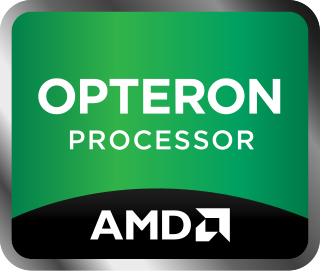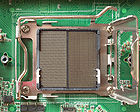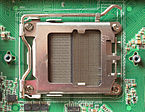HyperTransport (HT), formerly known as Lightning Data Transport, is a technology for interconnection of computer processors. It is a bidirectional serial/parallel high-bandwidth, low-latency point-to-point link that was introduced on April 2, 2001. The HyperTransport Consortium is in charge of promoting and developing HyperTransport technology.

Opteron is AMD's x86 former server and workstation processor line, and was the first processor which supported the AMD64 instruction set architecture. It was released on April 22, 2003, with the SledgeHammer core (K8) and was intended to compete in the server and workstation markets, particularly in the same segment as the Intel Xeon processor. Processors based on the AMD K10 microarchitecture were announced on September 10, 2007, featuring a new quad-core configuration. The last released Opteron CPUs are the Piledriver-based Opteron 4300 and 6300 series processors, codenamed "Seoul" and "Abu Dhabi" respectively.

The Athlon 64 is a ninth-generation, AMD64-architecture microprocessor produced by Advanced Micro Devices (AMD), released on September 23, 2003. It is the third processor to bear the name Athlon, and the immediate successor to the Athlon XP. The Athlon 64 was the second processor to implement the AMD64 architecture and the first 64-bit processor targeted at the average consumer. Variants of the Athlon 64 have been produced for Socket 754, Socket 939, Socket 940, and Socket AM2. It was AMD's primary consumer CPU, and primarily competed with Intel's Pentium 4, especially the Prescott and Cedar Mill core revisions.

Sempron has been the marketing name used by AMD for several different budget desktop CPUs, using several different technologies and CPU socket formats. The Sempron replaced the AMD Duron processor and competed against Intel's Celeron series of processors. AMD coined the name from the Latin semper, which means "always", to suggest the Sempron is suitable for "daily use, practical, and part of everyday life". The last Semprons were launched in April 2014. The brand was retired with the launch of the AMD A-Series APUs.

Socket 939 is a CPU socket released by AMD in June 2004 to supersede the previous Socket 754 for Athlon 64 processors. Socket 939 was succeeded by Socket AM2 in May 2006. It was the second socket designed for AMD's AMD64 range of processors.

Socket 940 is a 940-pin socket for 64-bit AMD Opteron server processors and AMD Athlon 64 FX consumer processors. It was one of the first sockets designed for AMD's AMD64 range of processors.

The Socket AM2, renamed from Socket M2, is a CPU socket designed by AMD for desktop processors, including the performance, mainstream and value segments. It was released on May 23, 2006, as a replacement for Socket 939.
The AMD Family 10h, or K10, is a microprocessor microarchitecture by AMD based on the K8 microarchitecture. The first third-generation Opteron products for servers were launched on September 10, 2007, with the Phenom processors for desktops following and launching on November 11, 2007 as the immediate successors to the K8 series of processors.

Socket S1 is the CPU socket type used by AMD for their Turion 64, Athlon 64 Mobile, Phenom II Mobile and later Sempron processors, which debuted with the dual-core Turion 64 X2 CPUs on May 17, 2006.
The AMD Quad FX platform is an AMD platform targeted at enthusiasts which allows users to plug two Socket F Athlon 64 FX or 2-way Opteron processors (CPUs) into a single motherboard for a total of four physical cores. This is a type of dual processor setup, where two CPUs are installed on a motherboard to increase computing power. The major difference between the platform and past dual processor systems like Xeon is that each processor has its own dedicated memory stores. The Quad FX platform also has HyperTransport capability targeted toward consumer platforms.

Socket AM2+ is a CPU socket, which is the immediate successor to Socket AM2 that is used by several AMD processors such as Athlon 64 X2. Socket AM2+ is a mid-migration from Socket AM2 to Socket AM3 and both AM2+ and AM2 socket CPUs and motherboards have the potential to operate together. Actual interoperability depends upon other factors, especially the availability of compatible BIOS firmware, and some PC manufacturers, such as Dell, have not provided compatible BIOS versions that allow use of socket AM2+ CPUs on their products utilizing socket AM2 motherboards, such as the Inspiron 531. It was released in November 2007.
AMD Turion is the brand name AMD applies to its x86-64 low-power consumption (mobile) processors codenamed K8L. The Turion 64 and Turion 64 X2/Ultra processors compete with Intel's mobile processors, initially the Pentium M and the Intel Core and Intel Core 2 processors.

Athlon II is a family of AMD multi-core 45 nm central processing units, which is aimed at the budget to mid-range market and is a complementary product lineup to the Phenom II.

Socket C32 is a zero insertion force land grid array CPU socket designed by AMD for their single-CPU and dual-CPU Opteron 4000 series server CPUs. It is the successor to Socket AM3 for single-CPU servers and the successor for Socket F for lower-end dual-CPU servers. Socket C32 supports two DDR3 SDRAM channels. It is based on the Socket F and uses a similar 1207-pin LGA socket but is not physically or electrically compatible with Socket F due to the use of DDR3 SDRAM instead of the DDR2 SDRAM that Socket F platforms use.
AMD Piledriver Family 15h is a microarchitecture developed by AMD as the second-generation successor to Bulldozer. It targets desktop, mobile and server markets. It is used for the AMD Accelerated Processing Unit, AMD FX, and the Opteron line of processors.











